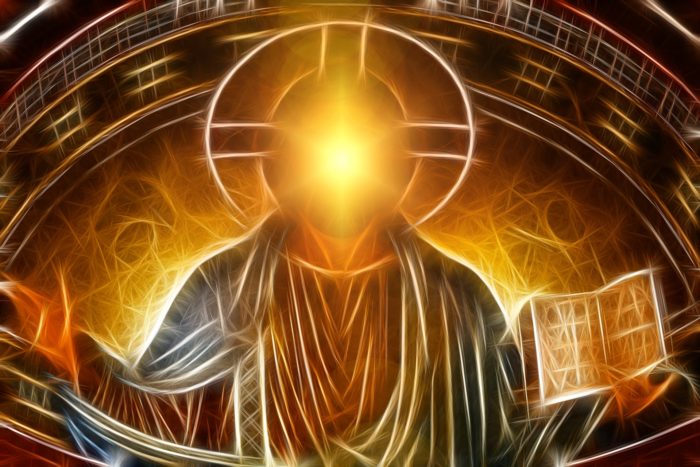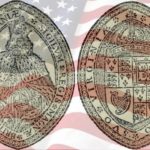
Religion, Politics, And Bloodlines – The Jesus Conspiracy
- By
- June 27, 2018
- September 26, 2021
- 9 min read
- Posted in
- Conspiracy Theory Analysis, Historical
The story of Jesus Christ has fascinated much of the world’s population for thousands of years. Some have followed interpretations of his life blindly and without question. Others have dismissed any notion of such a man just as hastily. Some, though, particularly throughout the twentieth century with the diminishing threat of “The Church” and accusations of heresy largely a thing of the past, have questioned both sides of those stances.

Dramatic image of Jesus Christ
Like many tales shrouded in purposeful ambiguity and enigmatic riddles, the apparent truth lays somewhere in between the unquestioning belief and the outright rejection. And furthermore, it would also appear that certain societies, families, and mysterious individuals throughout history have also known this truth. And kept it hidden from the population at large. Indeed, it would appear there is still more to learn, of the past and the future to come. And the knowledge, wisdom, and secret writings to understand exactly why this bloodline is so special in the first place.
Perhaps we should start looking at the Jesus Conspiracy by returning to the around 325 AD at a time when the Roman Emperor Constantine began what would be the Christian movement, making Christianity the official religion of Rome, and in turn, over the centuries, of much of the Western World.
Contents
Constantine and Sun Worship
Constantine is largely seen as having united people behind Christianity. Indeed, his title “Constantine The Great” is an apparent reflection of this. In truth, however, not only was Constantine not of the Christian faith, (at the time an “off-shoot” of Judaic teachings since the fall of Jerusalem in 70 AD), his version of it was merely a mask for the ancient Sun religion whose followers worshipped the sun god, Sol Invictus. Constantine was a high priest of this ancient religion and remained so until his death. It was also a way of maintaining control over the people of Jerusalem as well as of those who practiced many of the “off-shoot” Judaic teachings.
Until Constantine’s reform of the ancient texts and scriptures into what would become the New Testament, even those in the “pre-Christian” groups observed many Jewish traditions. The day of the Sabbath, for example, was on Saturday. However, Constantine would have this moved to the day of his ancient Sun worship – Sunday. The sun god, Sol Invictus was celebrated on 25th December, and so Jesus’s birthday was placed at this date accordingly. Even the Roman stories of Romulus and Remus were modified and became Saint Peter and Saint Paul. Depictions of divinity would also begin to appear with a halo. This, in reality, was another reference to the sun and Sol Invictus. Nobody questioned these changes, and it allowed those such as Constantine to follow their own ancient, mystic teachings, secretly in plain sight.
The masses, in the meantime, those who saw Jesus as their savior, who had stood against Roman occupation, could now worship him under that same Roman rule. Although in reality, the traditions they were observing were not Christian or Judaic at all.
A Land Riddled With Political Unrest
If we take divinity out of the equation, why was Jesus so important to the people of Jerusalem even before Constantine’s reforms and creation of the Christian faith? It is accepted by many historians – mainstream and alternative – that “Jesus” did exist roughly around the time the ancient texts tell us he did. His being the “son of God” to a “virgin mother”, however, are largely parts of the twists and additions at the behest of Constantine.
At the time of Jesus’s life, Palestine was under Roman rule and had been for almost half a century. However, they had their forces in various parts of the world and couldn’t rule directly. Instead, they appointed “kings” to rule for them. The first of these was Antipater, who ruled from 63 to 37 BC. Following his reign, Herod The Great would rule until 4 BC. After his death, Rome would divide the region between his three sons, and his sister.
However, by 6 AD, Judea (which included Jerusalem) would come under direct Roman rule. Whereas the population enjoyed general freedom under the puppet kings of the Romans, the Romans themselves were much more heavy-handed. According to the book The Holy Blood and the Holy Grail, any rebellion was met with strict penalties [1] and around 3,000 such rebels were crucified as a warning to further uprising. By the time Pontius Pilate assumed control in 26 AD, the situation was descending into chaos.
Although the rebellion had temporarily quietened, persistent rumblings continued. Ancient writings tell us that many different sects and cultures existed in Palestine at this time. However, closer study suggests that these different groups were one and the same. Furthermore, ancient records show one of their political and revolutionary leaders, had the name, Jesus.
Purposeful Misinterpretation?
The origins of the story of Christ as told in the New Testament and as widely believed today predates the apparent birth of Jesus by thousands and thousands of years. These basics, as mentioned above, were transferred to the New Testament and the “new” Christian religion to make up the story of Jesus by Emperor Constantine. However, many of the ancient writings that told a very different version of Jesus’s life would be hidden away before they could be destroyed. And they would remain so for thousands of years.
Upon the discovery of such writings as the Dead Sea Scrolls and the Gnostic Gospels in the mid-twentieth century, however, which would appear to have corroboration in various “non-Christian” texts, a much different picture of Jesus Christ, and in turn, a part of human history is told.
In the book The Hiram Key, Christopher Knight and Robert Lomas speak of the story of Jesus Christ as we know it today, [2] and point to a mistranslation, possibly purposeful, of his name, as well as an intriguing link to another mystery of biblical times. Jesus Christ is essentially the Greek translation of the old Hebrew writings. In reality, many scholars agree, “Jesus” was very likely Yehoshua in Hebrew. The broad translation of this is “he who brings victory”. What is most intriguing, however, is that Yehoshua would most likely be Joshua by modern interpretations. In the old testament writings, it was Joshua, with the Arc of the Covenant, who would lead the victory in Jericho when the walls tumbled following the trumpet blasts. Might Joshua and Jesus be the same person, but separated during the “cobbling together” of the New Testament?

Ancient writings
Jesus “the” Christ
Christ is another Greek translation, from the Hebrew word “messiah”. Although modern day Christians take this to mean “the savior” or “bringer of salvation”, the Hebrew meaning for the word is roughly the “rightful king of the Jews”. However, this meaning of “king” was one of leadership, of a “literal” king, of royal blood and with a Kingdom to rule over. As Knight and Lomas point out, the translation should be, Jesus the Christ. Jesus the royal and very Earthly, king.
With the Roman rule becoming increasingly hated among the general population, it would appear Jesus wasn’t seen as a divine savior sent from above. He was of a royal bloodline, very likely of one of the wealthy, politically astute families of the region, and one who had a “legitimate” claim to rule before the invasion of the Roman Empire. And someone who was very influential among the people.
Furthermore, their organization skills and numbers were increasing, and uprisings were more and more likely. This was something not at all lost on Pontius Pilate, who for all his cruelty, was a clever man. By the early-30s AD, in an attempt to quell these uprisings once and for all, he would arrest and charge the ringleaders of these groups. Including, and perhaps especially, the man claiming to lead his people with crimes against Rome. Their rightful king, Jesus (the) Christ.
That Jesus was crucified is an indication that his alleged crimes were against Rome. Essentially the modern-day equivalent would be acts of terror or treachery against the state. Crucifixion would go ahead for these crimes only.
Who Was Jesus Barabbas?
It is interesting that the New Testament appears to suggest that Jewish religious leaders urged the Romans to crucify Jesus for lesser crimes. Had this been the case, they had the power to carry out death sentences themselves. If they did so, it would usually be by stoning. Some people believe this notion was placed into the New Testament to create a division with the Orthodox Jewish community at the time, and to distance Rome’s influence in the matter.
Perhaps this attempt to sow division is also apparent in the claims of the baying crowd being told they could release one of the prisoners about to be executed. As the New Testament shows, they would choose a thief named Barabbas. Again, according to the New Testament, this suggests that Jesus’s own people neglected to save him, instead choosing to save a common thief. As well as reinforcing that division, it further distanced Rome from their responsibility in Jesus’s death.
However, a “common thief” would not have been crucified in such a manner for his crimes. So that would suggest he too was guilty of crimes against Rome. But who was Barabbas? According to the Gospel of Matthew, his full name was Jesus Barabbas. And according to some, he was Jesus Christ. They claim Barabbas is a corruption or mistranslation of Jesus Berabbi. Berabbi would be a title after a rabbi’s first name who had an extremely high standing among his peers. As “king (leader) of the Jews”, this would certainly apply to Jesus. Others, however, believe it stems from “Jesus bar Abba” – which would mean “son of the father”. And like it sounds, would imply Jesus Barabbas, was Jesus Christ’s son.

The Crucifixion
The Crucifixion Cover-Up
Whether Jesus was released or his son was, many ancient writings state unreservedly that Jesus did not die on the cross. As you might imagine there are various versions of this event. Some state that while the crowds did see Jesus flogged before the crucifixion, it was someone else on the cross. According to some texts, a “replacement” would take his place at the last moment. If we accept that Jesus was a political leader against the oppressive Roman regime, and from a considerably wealthy family at that, this isn’t that much of a stretch of the imagination. Others believe it was certainly Jesus upon the cross, but that he didn’t die. It was only made to look like he did. And there are several reasons for these claims.
Firstly, the site of the crucifixion would take place on land owned by Joseph of Arimathea, who just happened to be an uncle to Jesus. He was also a person of great influence, both with Jewish leaders and the Romans. Remember again the claims of Jesus coming from an extremely wealthy and prominent family. Much different from the poor child born in a stable.
This land was far from the crowd, according to any official records eluding to it. And furthermore, most crucifixions would drag on for days before the victim finally succumbed to death. As was the point of them. Yet Jesus’s was over within hours. And even then, a Roman soldier apparently “pierced his side” to show mercy and end his life – something the Romans surely wouldn’t have done. Given Pilate’s “openness” to deals, as well as his need to quash the uprisings without enflaming further resistance, this is more plausible than it might at first seem.
Davidic Bloodlines In Europe?
Some believe Jesus would travel east where he would live out his days in relative secrecy. And, again, we should note the likely wealth and resources at his disposal. Not to mention the “elite contacts” such wealthy families shared, making this plausible. Others, though, believe he may have headed towards the south of France. And if he didn’t, his wife, Mary Magdalene, with his child did.
Records tell us that Pilate had a residence there. And the area at the time was one under the control of Rome, so he certainly had the influence. It is also worth bearing in mind that many churches in this region of France are overwhelmingly dedicated to Mary Magdalene, [3] suggesting a definite connection as opposed to one of legend. And furthermore, the Dead Sea Scrolls states clearly she was the wife of Jesus. If we accept that Jesus was of royal descent and was “a king in waiting”, then his wife would receive royal treatment also, for she would carry the bloodline on with his child. And if she did, with or without Jesus, find sanctuary in the south of France, then that would also suggest, given “royal” connections, that that bloodline continued somewhere in Europe.
There are records of the Desposyni which mean “of the Lord”. They would claim descendancy from Jesus. They would ultimately perish or go into hiding at the hands of the Roman Church around 200 AD. Many believe Jesus’s descendants would marry into the Merovingian bloodline. This bloodline would be one of the most powerful families in Europe around the late-400s to the late-800s. They would claim, through these descendants, a genuine link to King Solomon and the House of David, ancestors of Jesus.
Many groups and bloodlines have claimed such connections to Jesus since then.

Statue of Jesus
Link To The “God-Kings” of Antiquity?
Some of these claimants to apparent “divinity”, such as the Knights Templar and the Freemasons, we will look at in more detail in future articles. There are some today, however, who claim a genuine descendancy to Jesus. One such person, Hugh Montgomery, makes an interesting case. He states that he can trace his lineage right the “way back to the God-Kings of Mesopotamia”. [4]
This is an interesting statement indeed. Particularly if we entertain for a moment the claims that some of these ancient Gods, whether in Mesopotamia, Ancient Egypt, or Sumer, were alien-human hybrids. With their ancestry ultimately being of an extraterrestrial nature going back to the beginning of time. Might this explain why the bloodline of Jesus is so special and of such importance? Or more to the point, might this explain the secrecy surrounding this importance?
It is perhaps important to remember that the troubles and violence didn’t stop following the apparent crucifixion of Jesus. If we accept this happened around 32/33 AD, the conflicts and uprisings would continue for over one-hundred years. In fact, until 135 AD with Emperor Hadrian’s apparent “expelling of the Jews” from Judea. Even at the time of Constantine in the early-300s, “splinter groups” would follow “ancient Judaic teachings”. And perhaps in sympathy, the discontent was still prevalent. Indeed, it was this discontent and Constantine’s fear of such an uprising that the New Testament came into existence.
This allowed him to control the masses. And at the same time suppress any writings or teachings that didn’t follow those of the New Testament. It would be a method used for over a thousand years with deathly consequences. And one still used today but in a reworked format of mental control through ignorance, dependency, and rampant consumerism.
https://www.youtube.com/watch?time_continue=1640&v=dAqtuRS5ilg
References
| ↑1 | The Holy Blood and the Holy Grail, Michael Beigent, Richard Leigh, and Henry Lincoln, ISBN 9780099 503095 |
|---|---|
| ↑2 | The Hiram Key: Pharaohs, Freemasons, and the Discovery of the Secret Scrolls of Jesus, Christopher Knight and Robert Lomas, ISBN 9780099 699415 |
| ↑3 | Gnostic Scriptures and Fragments, The Gospel According to Mary Magdalene, The Gnostic Society Library http://gnosis.org/library/marygosp.htm |
| ↑4 | The God-Kings of Europe: The Descendents of Jesus Traced Through the Odonic and Davidic Dynasties, Hugh Montgomery, ISBN 9781585 091096 |
Fact Checking/Disclaimer
The stories, accounts, and discussions in this article may go against currently accepted science and common beliefs. The details included in the article are based on the reports, accounts and documentation available as provided by witnesses and publications - sources/references are published above.
We do not aim to prove nor disprove any of the theories, cases, or reports. You should read this article with an open mind and come to a conclusion yourself. Our motto always is, "you make up your own mind". Read more about how we fact-check content here.
Copyright & Republishing Policy
The entire article and the contents within are published by, wholly-owned and copyright of UFO Insight. The author does not own the rights to this content.
You may republish short quotes from this article with a reference back to the original UFO Insight article here as the source. You may not republish the article in its entirety.




